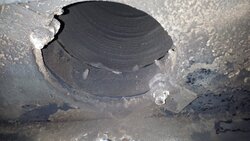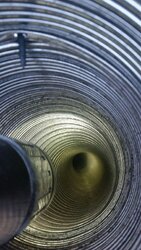Hi Everyone,
I've been burning wood in an open fireplace for 25 years, decided to put an insert in last year, a Pacific Energy Neo 2.5. I did my first liner sweep, the top of the liner was spotless, just a slight brownish "smoke cured" look to it, but at the bottom, inside the insert, it was filthy (see picture). Does this look and sound normal? The "soot / powder" I removed from the bottom was quite a bit I thought, maybe enough to fill a half gallon milk container. Very powdery and had a metallic gleam to it, no tar or sticky sap like gunk. I decided not to insulate the liner as the chimney is only exposed 10' to the exterior (2 story colonial). The chimney is partially inside the garage then above the garage in attic space, then exposed the final 10 feet. I have no problems drafting when lighting a fire.
Thanks in advance for your thoughts.....

I've been burning wood in an open fireplace for 25 years, decided to put an insert in last year, a Pacific Energy Neo 2.5. I did my first liner sweep, the top of the liner was spotless, just a slight brownish "smoke cured" look to it, but at the bottom, inside the insert, it was filthy (see picture). Does this look and sound normal? The "soot / powder" I removed from the bottom was quite a bit I thought, maybe enough to fill a half gallon milk container. Very powdery and had a metallic gleam to it, no tar or sticky sap like gunk. I decided not to insulate the liner as the chimney is only exposed 10' to the exterior (2 story colonial). The chimney is partially inside the garage then above the garage in attic space, then exposed the final 10 feet. I have no problems drafting when lighting a fire.
Thanks in advance for your thoughts.....

Last edited by a moderator:


